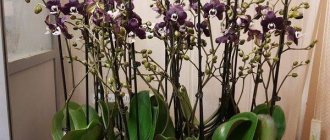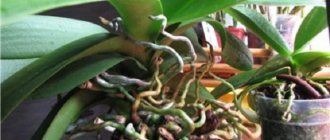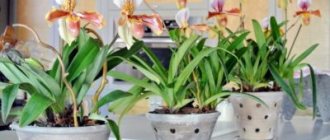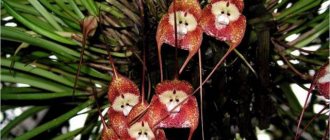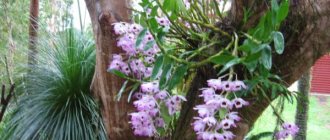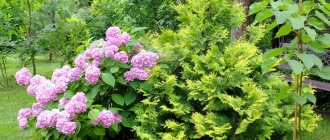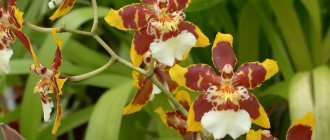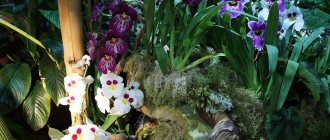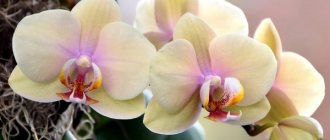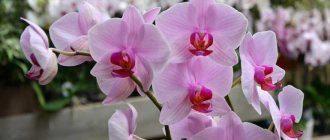Description
There are now a lot of hybrid varieties of orchids, which is facilitated by the popularity of these indoor plants.
Many gardeners specialize exclusively in growing orchids; some prefer scented phalaenopsis . This type includes the Liodoro standard, which is also called Sweet memory.
The variety was officially registered in the early 80s of the last century by an American company; Rex Smith is considered the author of the variety.
It was this man who, by crossing Phalaenopsis Deventeriana and Phalaenopsis violacea, was able to breed Liodoro and presented his creation to the whole world.
During the first years of its existence, the standard was able to collect more than 30 various awards in the field of floriculture.
The new hybrid quickly won the hearts of flower growers; its spread was especially facilitated by the appearance of the flowers and the smell they emitted.
The unusual color of the flowers, shape, and aroma the shiny leaves were also inherited . produced tall peduncles and a fairly large flower size from Phalaenopsis Deventeriana.
Photo of Liodoro orchid.
Description and photo of the flower
Liodoro orchid flowers are something that makes it worth painstakingly caring for the plant. First, large buds appear, 5 at a time. When they bloom, the room will be filled with a delightful aroma.
The Liodoro flower is large, about 7 cm. Star-shaped petals flowing from pink to yellow, a triple lip, wide oval sepals - yes, this flower is beautiful.
Distribution in nature
In nature, the parents of the Phalaenopsis Liodoro orchid can be found in the Malaysian tropical forests , where they grow on trees and between stones. In addition, the Phalaenopsis violacea variety is found on the northern coast of Australia and China.
Interesting! The distribution area is limited to these areas; in other areas of the globe, this type of phalaenopsis does not grow in the wild.
Signs associated with the Liodoro variety
“When a woman is given orchids, she feels as if she is floating on a cloud of perfect possibilities” (The Perfect Man). And indeed it is. The orchid symbolizes female sexuality. The seeds and petals have long been used in love magic to make potions. Phalaenopsis Liodoro is considered a female plant that enhances femininity and attractiveness.
People attribute orchids to a negative influence on men, which makes them pampered, and it is not recommended to place it in bedrooms and rooms belonging to boys.
The calming properties of orchid pollen are also noted in Japanese traditions. Phalaenopsis is a kind of talisman for a woman, which will help develop talent and enhance creativity. But for this you need to sincerely take care of the flower, avoiding diseases and wilting of Liodoro. Then the plant will prolong and even restore a woman’s youth, strength and health. It will give you attractiveness and emphasize femininity.
It is believed that in a person who enters a woman’s apartment with evil thoughts, Phalaenopsis will cause a loss of strength and a desire to leave as quickly as possible. They say that secret and obvious enemies of the owner of the flower begin to suffer from headaches and fall into anxious states.
It will also be interesting: Schiller's Phalaenopsis - caring for an orchid at home?
External characteristics
The Liodoro standard is classified as a medium hybrid; the plant has the following characteristics:
- in height can reach up to 70 cm in length, including the peduncle;
- the leaves on it are located on both sides of the stem, can reach 25 cm in length, and grow up to 12 cm in width. Their edges are slightly wavy, the leaf plate itself is a rich green color;
- Phalaenopsis Liodoro shoots a medium-sized frog, during flowering it continues to grow and develop, the maximum peduncle can reach a length of 50 cm;
- the flowers have an unusual shape, they look like can reach 7 cm in diameter .
Interesting! This standard is considered one of the most beautiful phalaenopsis.
Brief botanical description and appearance
By its origin, this species is a hybrid . It is distinguished by a light green tint of the leaf blade, sometimes the pallor reaches a yellow color. Peduncles, like the entire plant, are characterized by large sizes.
An interesting feature of Liodoro is its alternate flowering, that is, the second phase of flowering will not begin until the first phase of this process ends.
This distinctive feature makes it possible to maximize the flowering period, and therefore the attractiveness of the crop.
For this feature, people called this orchid “revolver”. One can highlight another extraordinary feature of this type of phalaenopsis: its pleasant aroma, giving off sweet notes.
The color range of the buds is quite diverse: it starts with yellow and ends with deep pink , and in rare cases - purple shades. Moreover, the intensity of the color itself directly depends on the care parameters provided by the owner of the plant. Often the flower stalks hang down under the weight of the buds.
Features of flowering
Each hybrid variety of phalaenopsis has its own growth or flowering characteristics, the Liodoro orchid is no exception. This standard is characterized by:
- long flowering, which can last at home if all necessary nuances are observed for up to two years;
- The plant does not need a period of rest in order to regain its strength. Immediately after the peduncle has faded and dried up, a new arrow may grow;
- The phalaenopsis Liodoro orchid is characterized by revolving flowering, in which 3-5 flowers can bloom at once, after a while the same number of flowers bloom, and so on;
- During the entire flowering period, the peduncle actively develops further, releasing more and more branches with buds.
Flowering Liodoro.
Don’t be alarmed if the standard shoots out several flower stalks at once, but only one continues to fully develop. After flowering, it is worth removing the arrow, only then the second one will begin to develop.
Important! It is not necessary to stimulate flowering of the trunk. In order for the flower to bloom regularly, it is enough to strictly adhere to the care tips and feed it regularly.
Flowering period
With proper care, Liodoro can bloom all year round. The plant must reach the age of one and a half years, after which it will flower for more than two years.
If out of several flower stalks only one blooms, then this is a signal that the flower lacks minerals. And the complete absence of blooming flowers indicates problems with lighting, temperature changes or rearranging the pot.
At the end of flowering, you should not cut off the flower stalks, because they continue to develop from above. Remove it when it is completely dry.
Transfer
The standard is usually grown in transparent plastic pots, but it will also develop well in ceramic containers, as well as in flat bowls.
The plant is replanted no more often than once every two to three years ; the main indicator for this will be the compaction of the substrate. Because of this, the root system begins to dry out poorly and air permeability deteriorates. This can cause many diseases.
The best time to change the substrate is considered to be the period immediately after flowering. Before carrying out the procedure, it is necessary to prepare the soil; for this, a mixture of the bark of coniferous trees of different fractions with pieces of sphagnum moss is ideal.
Liodoro Orchid transplant.
If you plan to grow Liodoro on blocks, then it is better to lay a layer of sphagnum between the roots. Moss will help retain moisture longer.
Pot and soil for planting
An orchid can grow in ceramic flowerpots, but it still prefers transparent containers, since for its normal development it is necessary that the roots also receive light.
The soil for the flower must be permeable to water and air . You can buy special soil for orchids at a flower shop. When preparing the substrate yourself, you need to take in equal proportions:
- river sand;
- peat;
- perlite;
- sphagnum moss;
- conifer bark.
Care
Orchid variety Liodoro belongs to heat-loving trunks; the norm for development and flowering for it is considered to be:
- from 25 to 30 degrees during the day;
- from 15 to 20 at night.
Important! An orchid requires a difference between day and night temperatures.
The humidity in the room where phalaenopsis grows should be at least 50% , but it doesn’t need to be high either.
After purchase, the standard will not require special care. It is worth watering the flower, as soon as the substrate dries, spray it.
Feeding should be done moderately ; in stores and greenhouses, flowers intended for sale are fertilized especially abundantly; the supply will last for a month and a half.
But it is not worth replanting the trunk after purchase; this is done in case of emergency, if the flower is sick or pests have appeared on it.
In order for phalaenopsis to please the eye with flowering as often as possible, it is necessary to strictly follow the rules of care . Then the stem will not need stimulation, and flowering will be regular.
Like other varieties, Phalaenopsis Liodoro requires pruning of the peduncle. This is not done immediately, but only after it begins to dry out. But sometimes the green arrow is also cut off after the last flower has fallen; this is done only in the case when the stem has driven out two or more peduncles, but only one of them has developed.
The following will help protect you from diseases and pests:
- regular transplantation;
- moderate watering;
- feeding
Regular feeding will help in the fight against pests and diseases.
Advice! Even in the hottest summer, it is undesirable to take the Liodoro orchid out into the open air; it is better to let the stem be in a well-ventilated area.
Preventing problems
To protect your beauty from illness, you need to follow the recommendations for caring for the crop, which are not so complicated . And it is advisable not to place flowerpots with orchids next to each other to prevent the transmission of diseases and pests from one flower to another.
Orchids come in different colors and varieties.
Possible problems during cultivation
Growing phalaenopsis of any variety at home is not entirely easy. In order for a flower to delight you with lush greenery and frequent flowering, you will need to make some efforts.
Each species will have its own growing characteristics, Liodoro most often suffers from:
- drying of the roots , this indicates that the trunk is not receiving enough moisture. They combat this with more frequent watering and regular hot showers for the stem;
- the second problem may be a long absence of peduncles. There may be several reasons for this: the absence of differences between daytime and nighttime thermometer readings;
- incorrectly chosen place of residence;
- compacted soil.
Having found out the reason, it is worth taking measures to eliminate it and the plant will definitely delight you in the near future with a peduncle and star-shaped flowers on it.
Advice! The plant feels best in well-lit areas without direct sun, but will also grow well in partial shade.
Distinctive feature
Phalaenopsis Liodoro has several distinctive features:
- Long flowering . With good care and compliance with all its subtleties, it can bloom for up to 2 years.
- The variety is revolving . This means that as soon as one flower stalk fades, it is replaced by another. There is no rest period.
- Pleasant aroma . Liodoro is distinguished from other species by the smell of lily of the valley with notes of lime.
Attention! This type of orchid is a high-maintenance plant. Only after receiving proper care will it grow well and delight you with flowering.
Reproduction
Phalaenopsis Liodoro is propagated at home only by separating the babies. Most often, youngsters emerge from dormant buds or grow from a stem.
You can separate only when the baby has at least 5 aerial roots and 3 leaves.
It is better to plant in prepared sphagnum moss, and when the trunk begins to grow, plant in a substrate of bark and moss.
A young Liodoro orchid has a baby (the baby is shown by an arrow).
Home care
What you need to know to ensure that the conditions for keeping the Liodoro orchid are correct:
- Watering. It is necessary to use only well-settled water at room temperature. During the period of active growth, the plant is watered abundantly, but make sure that there is a hole in the pot to drain excess water. And also, the higher the air temperature, the more often the orchid needs to be watered.
- Substrate. Consists of tree bark, fibrous peat and foam chips, replacing sphagnum moss. It should not be damp, otherwise the roots will begin to rot.
- Humidity. One of the most important factors in the life of orchids is air humidity. It should be at least 60%. To prevent the orchid from starting to lose its leaves, they are sprayed with tiny droplets of water from a spray bottle or a humidifier is placed nearby. It is important to know that excess moisture will lead to pests.
- Temperature. Take care to maintain the room temperature around 20 degrees Celsius during the day and 4-5 degrees lower at night. This is necessary for the appearance of buds.
- Lighting. Phalaenopsis needs a bright place, but shaded from direct sunlight. During the dark winter months, orchids' need for lighting can be met with artificial lighting.
- Choosing a location. This species will grow best away from central heating radiators and drafts.
- Transfer. Every two years, Liodoro is replanted in new pots and fresh substrate. It contains all the nutrients necessary for plant growth.
- Reproduction. Occurs in “babies” that form on peduncles. You need to wait until the roots grow 5 cm and 2-3 leaves appear. After this they are removed.
Phalaenopsis Liodoro: varieties of varieties
The most common variety of the Liodoro variety is Phalaenopsis Amber.
The hybrid is recognized by its rich purple-burgundy waxy flower ; in addition, the trunk is characterized by a shortened stem and thick aerial roots. The leaves are dense, green with slight wavy edges.
The plant shoots out the arrow twice a year, the flowers are round in shape, the petals are slightly pointed.
Flowering is accompanied by an intense aroma emanating from the flowers. At home, with proper care, the plant lives up to 15 years ; the trunk is rejuvenated by children.
Phalaenopsis Amber Yapon.
Diseases and pests
The main cause of orchid diseases is improper care . Insufficient watering, waterlogging, drafts, hard soil, poor nutrition - these are the main problems leading to diseases, especially fungal ones.
Common diseases of the Liodoro orchid:
- Fusarium . Characterized by the appearance of yellow leaves, rot on the stem and petioles. The diseased flower should be burned, and nearby plants should be treated with an insecticide.
- Anthracnose. Black spots appear on the leaves of the orchid. Treatment:
- cut off diseased leaves;
- and treat the plant with a solution containing copper (Bordeaux mixture, copper sulfate).
- Gray mold. Spots of mold appear on flower petals; as the disease progresses, the plant may become completely covered with them. At the beginning of the disease, you need to cut off the affected flower stalks and treat the flower itself with fungicides:
- Mikosan;
- Bordeaux mixture;
- Quadris.
- Powdery mildew . The manifestation of the disease is a white coating on the leaves. The disease progresses quickly and the plant can die within a week. Orchids are treated with a solution of colloidal sulfur.
- Black rot. The disease can be spread by harmful insects:
- aphid;
mealybug.
- Late blight . Dark spots appear on the plant and spread quickly. The infected parts must be removed, and the orchid itself must be treated with a fungicidal preparation.
- Viral diseases. They are usually carried by pests. Unfortunately, plants almost always have to be destroyed, since the virus cannot be cured. Signs of viral diseases:
- stripes on the leaves, first yellow, then black;
- spots on flower petals in the form of rings;
- colored stripes on flowers.
Rot develops at high humidity and excess fertilizer.
Pests of orchids are insects:
- aphid;
- spider mite;
- mealybug;
- whitefly;
- centipedes;
- snails;
- caterpillars.
If you find pests on a flower, wash it with a shower and treat it with a chemical. Insecticides can be used for this purpose :
- Aktellik;
- Fitoverm;
- Aktara;
- Neoron.
After treatment, it is advisable to cover the top of the flower with a bag for a day so that the insects die.
The main differences between hybrid varieties
Phalaenopsis have many varieties and species, most of them are hybrids that were bred by crossing two or more types of ordinary trunks. Each of the “parents” endowed their “child” with certain qualities.
It is easy to visually distinguish a regular variety from a hybrid one; representatives of natural varieties will not be able to adapt to the climate and home cultivation, and are rarely found on sale.
All trunks grown on the windowsill are hybrids , which were obtained by crossing two or more varieties of orchids.
Detailed description
The flowers of this variety grow small - up to 8 centimeters in diameter. The colors of the blossoming buds can be very varied : yellow, pink and even purple. Liodoro's petals do not at all look like “blooming butterflies”, but resemble a five-pointed star. The peculiarity of these flowers is the sweet aroma present.
Attention! The maximum size of buds directly depends on the growing conditions.
Flower arrows are medium in size - about half a meter. About five flowers can bloom on one peduncle. The leaves are dark green, very dense and fleshy. They usually reach a length of 25 centimeters and a width of 11.
Step-by-step care instructions
- Choosing a location . Since this plant is native to the tropics, it will need a lot of light. The ideal place is a windowsill with windows facing south. In rare cases, you can put it on the east or west side.
- Preparing the soil and pot. The florist must constantly monitor the condition of the roots, so a transparent and smooth pot is necessary. Novice gardeners should not make the soil mixture themselves; it is better to purchase ready-made soil in a special store. To prepare the substrate at home you will need:
- moss;
- coarse sand;
- pieces of bark;
- perlite;
- cork chips.
- Temperature . As mentioned above, any orchid requires a temperature difference. For the flower to feel good, it should fluctuate around +15..+28 degrees. This interval should be adhered to.
- Humidity . Increased moisture is the key to a healthy plant. This factor is very important for the orchid, so from time to time you need to spray the phalaenopsis with Liodoro. To raise moisture, you can place a container filled with water next to the pot.
- Lighting . A lot of diffused light is needed. There should be at least 13 hours of daylight. In summer, the flower is shaded, but with the approach of autumn, on the contrary, it is necessary to increase the illumination.
Watering . The hybrid loves moist soil, but do not overdo it. Soft water is suitable for irrigation. In summer, the procedure is carried out after 2-3 centimeters of the top layer of soil has dried. In winter, when daylight hours are short and temperatures are low, orchids can experience a slight drought. You need to be careful even after the phalaenopsis has bloomed. There are two ways to water: immersion or shower. In the first case, 10 minutes will be enough for the plant to be saturated; in the second, you need to let the water drain, and only after that return the pot to its place.
- Feeding . The flower needs fertilizer only at the moment of active growth. Supplements are applied once a week. It is prohibited to overdose and fertilize with nutritional complexes that are not intended for this species. To completely avoid fertilizing, it is worth changing the soil every two years.
- Transplant . In the first years after purchase, the orchid does not need to be replanted, unless it grows in Sphagnum moss. After this procedure, the flower needs nothing but complete rest. Phalaenopsis will independently adapt to new conditions and develop immunity.
We recommend watching a video about caring for the Liodoro orchid:
Bloom
When and how?
Liodoro has one of the longest flowering periods . This is due to the fact that the plant’s buds do not bloom all at once. Until the first flowers completely fade, the next buds will not open. The flowering period can occur at any time of the year, both in spring and autumn and even in winter, it all depends on the conditions created.
Features of care before and after
Before you start phalaenopsis, you need to carefully monitor the temperature; it should not be lower than +25..+27 degrees during the daytime, and at night fluctuations around +22..+24 degrees are acceptable. Orchid has a positive attitude towards light, so it will need as much as possible.
Tip : After the first buds wither, it is recommended to take the plant to a cool place, as this will promote new flowering. After a few months, the plant can be returned to its previous location. At the same time, watering is reduced.
What to do if it doesn't happen?
First you need to understand the reasons why flowering may not occur. Main reasons: incorrect room temperature. Day and night temperatures should differ from each other by at least 7-8 degrees. To provide the flower with this condition, you need to place the pot in a colder place at night. Phalaenopsis liodoro does not tolerate direct sunlight and its lack .
The grower who owns the plant will have to find a balance. Watering should not be abundant and the water should not be cold. If the orchid has recently been replanted, it will require a recovery period, which can last about six months.
How to call?
There are 2 ways to cause Liodoro to bloom . You can only use one of them:
- The easiest way is to provide optimal conditions for the orchid. This procedure will only cause flowering in healthy liodoro.
- The climate needs to change dramatically. Apply chemical fertilizing or spray with solutions.
Sub-varieties
The phalaenopsis variety includes about 70 subcultivars. Most of the subspecies are characterized by broad foliage of a rich green color, but there are flowers with beautiful patterns reminiscent of marble. Phalaenopsis has many different shades. The most popular ones include white, yellow, orange, light and bright pink orchids.
The main subvarieties: phalaenopsis Stewart, Schiller, pink, butterfly, phalaenopsis royal, Golden, Philadelphia, peloric, multiflora, liodoro.
